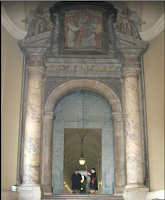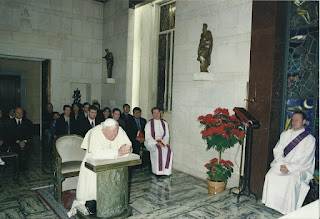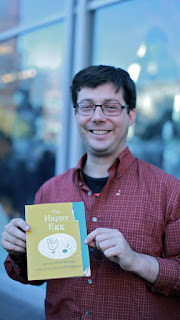Stones of Erasmus — Just plain good writing, teaching, thinking, doing, making, being, dreaming, seeing, feeling, building, creating, reading
29.12.23
Personal Revelation: Happy Birthday Post (To Me!)
 I am an educator and a writer. I was born in Louisiana and I now live in the Big Apple. My heart beats to the rhythm of "Ain't No Place to Pee on Mardi Gras Day". My style is of the hot sauce variety. I love philosophy sprinkles and a hot cup of café au lait.
I am an educator and a writer. I was born in Louisiana and I now live in the Big Apple. My heart beats to the rhythm of "Ain't No Place to Pee on Mardi Gras Day". My style is of the hot sauce variety. I love philosophy sprinkles and a hot cup of café au lait.
27.6.21
That Weekend I Stayed in a Small Mountain Town in the Mt. Baker-Snoqualmie National Forest (along the Cascade Mountain Range in Washington State)
In this post, I write about why fantasy for the rustic life is really a sham. I'm not made for the mountains. But I liked my visit to Skykomish, Washington.
 |
| "Sheeeeeeshhhhh!" |
 |
| The Empire Builder passes through Skykomish |
 |
| Fishbowl |
By the 1890s, the United States had already built a few transcontinental railroads — thanks to the unsung contribution of cheap Chinese labor — which the government tried to put a stop to with the Chinese Exclusion Act of 1882. Even though Washington D.C. put a smackdown on immigration from Asia, the economy begged to open more portals to the West. A direct train route to Puget Sound. Open more trans-Pacific trade. But a train through the Cascades would prove to be a more difficult challenge. The mountains are a formidable presence — up to about 4,000 feet above sea level, which for a Louisiana boy, is a lot. I'm breathing air at high altitudes, refilling my bottle with water from the Foss River.
 |
| Shoes Made for Walking? |
What’s your favorite picture that I took?
 I am an educator and a writer. I was born in Louisiana and I now live in the Big Apple. My heart beats to the rhythm of "Ain't No Place to Pee on Mardi Gras Day". My style is of the hot sauce variety. I love philosophy sprinkles and a hot cup of café au lait.
I am an educator and a writer. I was born in Louisiana and I now live in the Big Apple. My heart beats to the rhythm of "Ain't No Place to Pee on Mardi Gras Day". My style is of the hot sauce variety. I love philosophy sprinkles and a hot cup of café au lait.
22.6.21
All Aboard! The Capitol Limited is an Overnight Train between Washington, D.C. and Chicago (And Where I Hung Out with Mennonites)
In this post, I wax lyrical about the joys of long distance train travel via Amtrak. Also, I’ve started a travel log of sorts.
All who wander are not lost. If you know me you probably know I like to travel by train. It's been a bucket 🪣 list of mine to traverse the United States on every @amtrak route in the United States.
So far, I've relegated train travel to the South and North East regions. But, hey. Now that the country is opening up a bit more after a year or more of Covid-19 restrictions, I'm venturing West — along with the Capitol Limited, to Chicago — and stay tuned; later this week, I'm boarding the scenic Empire Builder train. Yay.
And of course, I've already met some fabulous folk. Lonnie is traveling from West Virginia after spending time “with his woman,” and Burke is a college student studying Chemistry. And it appears, this morning, I've just run into a gaggle of giggling Mennonite women just outside of Toledo, Ohio.
What should I do for my four-hour layover in Chicago? See y'all real soon, boo. Sprinkles!
 I am an educator and a writer. I was born in Louisiana and I now live in the Big Apple. My heart beats to the rhythm of "Ain't No Place to Pee on Mardi Gras Day". My style is of the hot sauce variety. I love philosophy sprinkles and a hot cup of café au lait.
I am an educator and a writer. I was born in Louisiana and I now live in the Big Apple. My heart beats to the rhythm of "Ain't No Place to Pee on Mardi Gras Day". My style is of the hot sauce variety. I love philosophy sprinkles and a hot cup of café au lait.
25.10.20
On How To Meet a Pontiff (Or, That Day I Attended a Private Audience with John Paul II)

|
|
When I was a Roman Catholic Seminarian, and the very young age of nineteen, I was in a private audience with the then Pontiff of the Roman Catholic Church, John Paul II |
To say that I met and chatted with the leader of the Roman Catholic Church would be a stretch. But I did kiss his ring. And I got to see him in his private chapel and in his private library in the Vatican.
I attended a private audience with about twenty-five other people — mostly priests and seminarians. It was the year 2000—around Christmas time—and I was in Rome with other American seminarians from the American College in Leuven, Belgium (where I was a college seminarian at the Catholic University of Leuven). At the time I was studying to be a priest, and our group was invited to have a private audience. The story went that when John Paul II was a seminarian in Krakow, Poland, his seminary was suppressed by the Nazis and apparently, the American College, in Leuven, had sent over, secretly, supplies, books, and the sort, to Poland, as a sign of support and solidarity.
We were in Rome for two weeks, staying as guests at the Pontifical North American College (located on the Janiculum hill) — but we didn't know what day our audience would happen. There are security protocols one follows when scheduled to meet the Pope. The Vatican gave a call to our group leader, a Benedictine priest named Aurelius Boberek, the night before and he then contacted us to be on the ready. We're meeting the pope!

|
| The Bronze Doors |
The night I heard the message I had to scrap my plans for the following day. I was planning to visit the catacombs of Saint Callistus. Oh well, I thought, a papal visit trumps all of that. So we had to wake up early — to arrive at the Bronze doors of the Vatican Apostolic Palace at the crack of dawn. You enter the doors from the right colonnade in Saint Peter's Square. Once we were green-lit to proceed, we were inside the Apostolic Palace — which extends as a grand loggia, designed by the Renaissance artist Raphael. It serves as an official portal and links up with the jumble of buildings that comprise the palace.
John Paul II had a private chapel in the papal apartments, located in the upper floors of what is officially called the Palace of Sixtus V, where he celebrated an early mass. It was so quiet when we arrived one could hear a pin drop. The Pope enters the sanctuary fully vested and he celebrated the Mass in the old Latin rite style — facing the altar (and not facing the people). I think I read one of the readings for the Mass (Or, maybe I read the intercessions. I cannot remember, exactly). So did my classmate Brent Necaise, who was a student with me — I was from Louisiana and he was from Mississippi). Afterward, the Pope's private secretary, a fellow by the name of Stanislaus Dziwisz, escorted us to the private study (or was it the library?) of the Pope.
It was Christmas time, so in the Pope's library there was a stately Christmas tree with ornaments painted with images of John Paul II. I remember thinking that was funny for some reason. I guess if you are Pope you get used to seeing your image affixed to everything from postage stamps, money, and ornaments. I remember all of the furniture was elegant but not overstated. It was a brightly lit room. And there was a wooden barrister bookcase with nicely appointed leather-bound books.
The Pope entered shortly after we had congregated and took a seat in a white plush chair. Everyone in our group lined up to meet him one by one, by kissing his ring, and stating our home state in the United States. When it was my turn he said softly, "Oh. The Mardi Gras," because it was announced I was a seminarian from Louisiana, and when another seminarian said he was from Kentucky he said, "Oh. Race horses." And it went like that — and each of us received a rosary and a holy card.

|
 I am an educator and a writer. I was born in Louisiana and I now live in the Big Apple. My heart beats to the rhythm of "Ain't No Place to Pee on Mardi Gras Day". My style is of the hot sauce variety. I love philosophy sprinkles and a hot cup of café au lait.
I am an educator and a writer. I was born in Louisiana and I now live in the Big Apple. My heart beats to the rhythm of "Ain't No Place to Pee on Mardi Gras Day". My style is of the hot sauce variety. I love philosophy sprinkles and a hot cup of café au lait.
11.7.20
Feast of Saint Benedict — Photos of Work and Community from My Time as a Benedictine Monk (c. 2004)
I had a Canon Sure Shot camera back then — and I would get my hands on black and white film and take photos of life in action. These photos are of jobs that I undertook when I was a relatively young monk in temporary profession (which means I had not yet made my final vows). At twenty-five years of age, I had just made my profession, and my life was caught up in the rhythm of work and community living.
We had a small barbershop in the monastery. If someone wanted a haircut they asked Br. Elias or Fr. Ambrose — and voilà you got a haircut. No need for SuperCuts.
 |
| Dom Gregory DeWitt created this painting on wood of Christ's first haircut. |
***
Often we would have to go to the nearby town to run errands, or to bring older members of the community to a doctor's appointment or to go shopping for this, that, and any other thing.
Outside of the monastery building were a set of benches where we could relax, talk, and if people were smokers, they could smoke.
Although most of us were not allowed to smoke, because the Abbot made a new rule saying younger members had to quit smoking, but those who had already developed the habit were silently allowed. Those were the rules.
For a couple of Summers, I was part of the camp program — where we had campers from across the state come in for weeks at a time; they stayed in a campground, replete with a chapel, cabins, swimming pool, dining area, and a Pavillion — about a quarter-mile from our community, but still on the property. On Sundays, the kids would come to the church for Mass and I would give a tour of the buildings, pointing out some of the features of Dom Gregory DeWitt's artwork. I love how in this photograph I have most of the kids' attention.
Lagniappe (More Photos)
 I am an educator and a writer. I was born in Louisiana and I now live in the Big Apple. My heart beats to the rhythm of "Ain't No Place to Pee on Mardi Gras Day". My style is of the hot sauce variety. I love philosophy sprinkles and a hot cup of café au lait.
I am an educator and a writer. I was born in Louisiana and I now live in the Big Apple. My heart beats to the rhythm of "Ain't No Place to Pee on Mardi Gras Day". My style is of the hot sauce variety. I love philosophy sprinkles and a hot cup of café au lait.
30.3.20
Library Poster: "Read a Book"
 I am an educator and a writer. I was born in Louisiana and I now live in the Big Apple. My heart beats to the rhythm of "Ain't No Place to Pee on Mardi Gras Day". My style is of the hot sauce variety. I love philosophy sprinkles and a hot cup of café au lait.
I am an educator and a writer. I was born in Louisiana and I now live in the Big Apple. My heart beats to the rhythm of "Ain't No Place to Pee on Mardi Gras Day". My style is of the hot sauce variety. I love philosophy sprinkles and a hot cup of café au lait.
20.1.19
Re-Post: Instagram Selfie
.
.
.
.
.
#scholar #cinephilecommunity #poet #filmbuff #cinephile#mizo #culturalcritic #moviereviews #whattowatch #culture#reviews #shillong #movies #indigenous via stonesoferasmus.com
 I am an educator and a writer. I was born in Louisiana and I now live in the Big Apple. My heart beats to the rhythm of "Ain't No Place to Pee on Mardi Gras Day". My style is of the hot sauce variety. I love philosophy sprinkles and a hot cup of café au lait.
I am an educator and a writer. I was born in Louisiana and I now live in the Big Apple. My heart beats to the rhythm of "Ain't No Place to Pee on Mardi Gras Day". My style is of the hot sauce variety. I love philosophy sprinkles and a hot cup of café au lait.
30.3.11
If You Try To Contact Me On My Website I May Just Respond (See Below For Details)
 |
| "Starry Night" gets more views than Stones of Erasmus. But Who's Counting. Google check your algorithm. |
1. spam. yuck. i don't eat the stuff
2. if you know me and just want to say, "hey"
3. hate mail. no one sends me hate mail to my other addresses, so why here? prolly won't happen
4. queries about hooking up (use another site)
5. homework help
6. queries to proofread (argghhh)Although, I will respond most expeditiously to the following messages:
1. corrections. i like to be corrected on factual stuff. i'm no wikipedia
2. suggestions
3. rants
4. raves
5. ways you used my content
6. blah blah
 I am an educator and a writer. I was born in Louisiana and I now live in the Big Apple. My heart beats to the rhythm of "Ain't No Place to Pee on Mardi Gras Day". My style is of the hot sauce variety. I love philosophy sprinkles and a hot cup of café au lait.
I am an educator and a writer. I was born in Louisiana and I now live in the Big Apple. My heart beats to the rhythm of "Ain't No Place to Pee on Mardi Gras Day". My style is of the hot sauce variety. I love philosophy sprinkles and a hot cup of café au lait.
30.3.10
Art: "Hands"
 I am an educator and a writer. I was born in Louisiana and I now live in the Big Apple. My heart beats to the rhythm of "Ain't No Place to Pee on Mardi Gras Day". My style is of the hot sauce variety. I love philosophy sprinkles and a hot cup of café au lait.
I am an educator and a writer. I was born in Louisiana and I now live in the Big Apple. My heart beats to the rhythm of "Ain't No Place to Pee on Mardi Gras Day". My style is of the hot sauce variety. I love philosophy sprinkles and a hot cup of café au lait.
17.12.09
Short Story: "The Levee"

 I am an educator and a writer. I was born in Louisiana and I now live in the Big Apple. My heart beats to the rhythm of "Ain't No Place to Pee on Mardi Gras Day". My style is of the hot sauce variety. I love philosophy sprinkles and a hot cup of café au lait.
I am an educator and a writer. I was born in Louisiana and I now live in the Big Apple. My heart beats to the rhythm of "Ain't No Place to Pee on Mardi Gras Day". My style is of the hot sauce variety. I love philosophy sprinkles and a hot cup of café au lait.


















